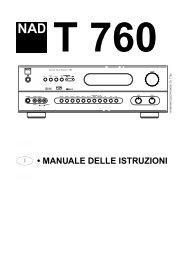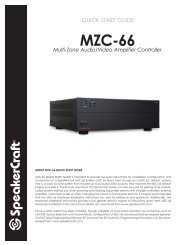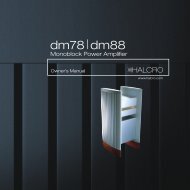Palladium® - Hi-Fi Di Prinzio
Palladium® - Hi-Fi Di Prinzio
Palladium® - Hi-Fi Di Prinzio
You also want an ePaper? Increase the reach of your titles
YUMPU automatically turns print PDFs into web optimized ePapers that Google loves.
Connecting the Loudspeakers - 2<br />
Connecting the Loudspeakers - 3<br />
The Terminal Panel<br />
As supplied, positive and negative terminals of the high and low frequency terminal pairs are strapped together<br />
with a two-way strap. This is how you should prepare the terminal panel for each wiring option.<br />
Standard Connection<br />
Bi-wiring Connection<br />
Bi-wiring<br />
Bi-wiring reduces unwanted interactions between the bass drivers and the midrange and treble units.<br />
True bi-wiring is connecting separate cables from the bass terminals and the midrange/treble terminals to<br />
a common connection at the amplifier. Several cable manufacturers produce specialized cables, where one<br />
cable jacket contains four cables, thus enabling bi-wiring within one cable cluster. This eliminates the need to<br />
run separate cables and simplifies connection. In any case, the method of connection is the same.<br />
Prepare the crossover panel as shown on the previous page. Proceed as with standard wiring, but connect one<br />
cable to the bass terminals of the speaker. Connect a second cable to the midrange and treble terminals. Refer<br />
to the diagram. After connection, tighten all the terminals with the supplied wrench as shown previously.<br />
HF<br />
AMPLIFIER<br />
Right Speaker<br />
Left Speaker<br />
No preparation<br />
needed<br />
Standard (Single) Wiring<br />
Loosen the terminals.<br />
Remove the straps<br />
Re-tighten all<br />
terminals hand tight<br />
Bi-amping<br />
Connecting each loudspeaker drive element to separate amplification offers the highest possible performance<br />
level. It is not necessary for the amplifiers in the treble and bass sections to be identical. In fact for tube amplifier<br />
enthusiasts, there are advantages to using smaller amplifiers in the treble and midrange sections as the<br />
smaller transformers offer the significant possibility of extended, sweeter treble response.<br />
The straps are left in place as supplied. Connection may be made to any pair of terminals.<br />
You will need two loudspeaker cables of equal lengths, one for each loudspeaker.<br />
Partially unscrew one positive and one negative terminal. Connect the positive (+ RED) terminal of the loudspeaker<br />
to the striped conductor, or (if you are using custom cable) to the conductor designated by the cable<br />
manufacturer. Connect the negative (– BLACK) terminal to the plain conductor. Do not connect the amplifier<br />
at this time.<br />
To multi-amp, the following criteria are essential:<br />
• The amplifiers should be phase coherent. In other words, all amplifiers should be, by design, phase non-inverting<br />
or phase inverting; or if not, should be connected so as to be all phase non-inverting or phase inverting.<br />
• The amplifiers must have identical voltage gains, or should be set up to have identical voltage gains.<br />
• The amplifiers must have low residual noise characteristics, especially in the midrange and treble sections.<br />
• Amplifiers in corresponding channels must be identical; i.e., both bass amplifiers must be the same and so on.<br />
HF<br />
If any of the above conditions are not met, separate amplification will be significantly worse than ordinary biwiring.<br />
If you are unsure about these concepts or unsure if your amplifiers meet these criteria, it is essential that<br />
you consult your Klipsch specialist dealer before proceeding further.<br />
Right Speaker<br />
AMPLIFIER<br />
Left Speaker<br />
MID /<br />
TREBLE<br />
AMP<br />
BASS<br />
AMP<br />
Bi-amping<br />
The mid/treble amplifier is bi-wired<br />
(One channel shown)<br />
Page 10 Page 11



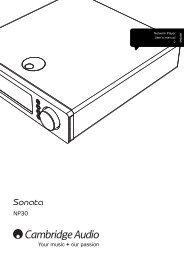
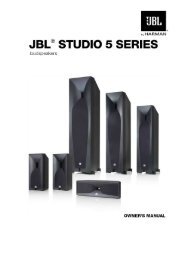
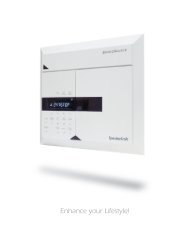
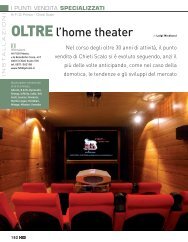
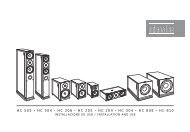


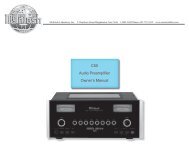
![Product Brochure [pdf] - Audio Classics](https://img.yumpu.com/22280099/1/190x245/product-brochure-pdf-audio-classics.jpg?quality=85)
